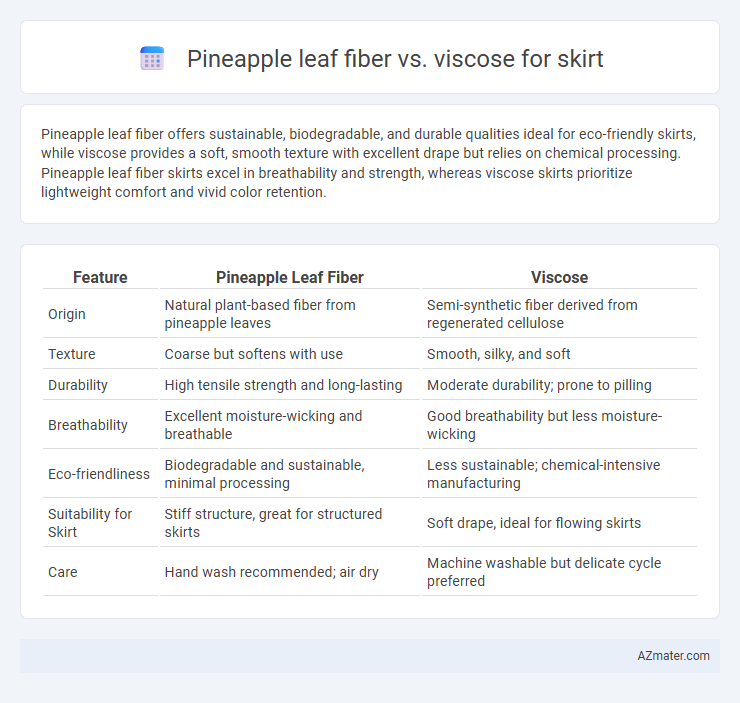Pineapple leaf fiber offers sustainable, biodegradable, and durable qualities ideal for eco-friendly skirts, while viscose provides a soft, smooth texture with excellent drape but relies on chemical processing. Pineapple leaf fiber skirts excel in breathability and strength, whereas viscose skirts prioritize lightweight comfort and vivid color retention.
Table of Comparison
| Feature | Pineapple Leaf Fiber | Viscose |
|---|---|---|
| Origin | Natural plant-based fiber from pineapple leaves | Semi-synthetic fiber derived from regenerated cellulose |
| Texture | Coarse but softens with use | Smooth, silky, and soft |
| Durability | High tensile strength and long-lasting | Moderate durability; prone to pilling |
| Breathability | Excellent moisture-wicking and breathable | Good breathability but less moisture-wicking |
| Eco-friendliness | Biodegradable and sustainable, minimal processing | Less sustainable; chemical-intensive manufacturing |
| Suitability for Skirt | Stiff structure, great for structured skirts | Soft drape, ideal for flowing skirts |
| Care | Hand wash recommended; air dry | Machine washable but delicate cycle preferred |
Introduction to Sustainable Skirt Fabrics
Pineapple leaf fiber offers a sustainable alternative to viscose in skirt fabrics, derived from agricultural waste with minimal environmental impact compared to the chemically-intensive viscose production. This natural fiber provides durability, breathability, and a unique texture while supporting eco-friendly practices and reducing reliance on synthetic textiles. Choosing pineapple leaf fiber for skirts aligns with sustainable fashion trends emphasizing renewable resources and lower carbon footprints.
Overview of Pineapple Leaf Fiber
Pineapple leaf fiber, derived from the leaves of the pineapple plant, is a sustainable and eco-friendly textile known for its high tensile strength and natural sheen, making it suitable for skirts with a unique texture and durability. Unlike viscose, which is a regenerated cellulose fiber from wood pulp requiring intensive chemical processing, pineapple leaf fiber offers a biodegradable alternative with minimal environmental impact. This fiber also provides breathability and moisture-wicking properties, enhancing comfort in skirt fabrics while supporting agricultural waste utilization.
What is Viscose?
Viscose is a semi-synthetic fiber made from regenerated cellulose derived from wood pulp, commonly used in the fashion industry for skirts due to its smooth texture and breathable quality. Pineapple leaf fiber, a natural sustainable alternative, offers durability and eco-friendly benefits but lacks the silky softness and drape of viscose fabric. Choosing between pineapple leaf fiber and viscose depends on preferences for environmental impact versus fabric feel and appearance.
Environmental Impact Comparison
Pineapple leaf fiber, derived from agricultural waste, offers a sustainable alternative to viscose by significantly reducing deforestation and water consumption during production. Viscose manufacturing involves extensive chemical use and high energy consumption, contributing to pollution and higher carbon emissions. Using pineapple leaf fiber for skirts supports biodegradability and lowers landfill waste, enhancing its eco-friendly credentials compared to viscose.
Softness and Comfort: Pineapple Leaf Fiber vs Viscose
Pineapple leaf fiber offers a natural, breathable texture with moderate softness, making skirts comfortable but slightly coarser compared to viscose. Viscose is renowned for its silky smoothness and excellent drape, providing superior softness and comfort in skirts ideal for sensitive skin. Both fibers have moisture-wicking properties, but viscose typically feels softer against the skin, enhancing overall wearability.
Durability and Longevity
Pineapple leaf fiber offers superior durability and longevity compared to viscose, as it is a natural bast fiber known for its strength and resistance to wear and tear. Viscose, a semi-synthetic fiber, tends to degrade faster with repeated washing and friction, leading to lower lifespan in skirt fabric. Skirts made from pineapple leaf fiber maintain structural integrity and color retention longer, providing more sustainable and long-lasting wear.
Breathability and Moisture Management
Pineapple leaf fiber offers superior breathability and moisture-wicking properties compared to viscose, making it ideal for skirts worn in warm climates. Its natural cellulose structure allows air to circulate effectively, reducing heat build-up and keeping the skin dry. Viscose, while soft and lightweight, tends to retain moisture longer, which can result in less efficient moisture management and reduced comfort during extended wear.
Aesthetic Qualities: Texture and Appearance
Pineapple leaf fiber offers a unique, natural texture with a slightly coarse yet elegant appearance, creating skirts that stand out with organic, artisanal charm. Viscose boasts a smooth, silky surface and a vibrant, glossy finish, ideal for skirts that require fluidity and a polished look. Both fibers provide distinct aesthetic qualities, with pineapple leaf fiber emphasizing rustic sophistication and viscose delivering sleek, refined elegance.
Ease of Care and Maintenance
Pineapple leaf fiber skirts are highly durable, resistant to wrinkles, and require minimal washing, making them easy to maintain with simple spot cleaning and air drying. Viscose skirts, while soft and comfortable, tend to wrinkle easily and often need delicate hand washing or dry cleaning to preserve their texture and longevity. Choosing pineapple leaf fiber skirts offers hassle-free care with enhanced durability, whereas viscose demands more cautious maintenance to avoid damage.
Which is Better for Skirts: Pineapple Leaf Fiber or Viscose?
Pineapple leaf fiber offers superior sustainability and durability for skirts, providing a natural, biodegradable alternative that excels in moisture-wicking and breathability, making it ideal for eco-conscious fashion. Viscose, derived from wood pulp, delivers a soft, silky texture and drapes elegantly but involves chemical processing that raises environmental concerns. Choosing pineapple leaf fiber supports eco-friendly production and longevity, while viscose prioritizes comfort and aesthetic appeal.

Infographic: Pineapple leaf fiber vs Viscose for Skirt
 azmater.com
azmater.com